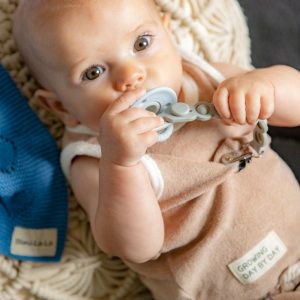Physical Address
304 North Cardinal St.
Dorchester Center, MA 02124
Physical Address
304 North Cardinal St.
Dorchester Center, MA 02124

Why do pacifiers relax babies? Pacifiers are a common sight for newborns and babies. These simple silicone or latex objects can be a lifesaver for parents, calming fussy babies and promoting longer stretches of sleep. But what is it about pacifiers that has such a relaxing effect on little ones?
Newborns are born with a strong sucking reflex. This reflex is present even before birth, and it serves several important functions:
Sucking is essential for newborns to get breastmilk or formula.
Sucking on fingers, fists, or pacifiers helps babies explore the world around them and self-soothe.
Sucking plays a role in the development of oral motor skills, which are important for future speech and eating.

When a baby sucks on a pacifier, it mimics the non-nutritive sucking they experienced in the womb. This sucking motion can trigger a calming reflex, similar to the one activated by rhythmic rocking or shushing.
Release of Calming Hormones: Sucking can stimulate the release of hormones like endorphins, which have pain-relieving and mood-boosting effects.
Regulation of Body Functions: Sucking may also help regulate a baby’s heart rate, breathing, and arousal state.
While the calming effect is a major benefit, pacifiers may offer other advantages:
Reduced Risk of SIDS: Studies suggest a possible link between pacifier use and a reduced risk of Sudden Infant Death Syndrome (SIDS). However, it’s important to follow safe sleep practices to minimize the risk of SIDS.
Pain Relief: Sucking on a pacifier can provide comfort and pain relief during minor procedures like vaccinations.
Improved Sleep: Pacifiers can help some babies fall asleep easier and stay asleep for longer stretches.

Pacifiers are not a magic bullet for soothing all babies. Here are some potential drawbacks to consider:
Interference with Breastfeeding: Frequent pacifier use in the early weeks may interfere with breastfeeding establishment.
Ear Infections: Some studies suggest a possible link between pacifier use and increased risk of ear infections.
Pacifier Dependence: Some babies can become overly reliant on pacifiers for comfort, making it difficult to wean them later.
If you’re considering using a pacifier for your baby, here are some tips:
Wait Until Breastfeeding is Established: If you’re breastfeeding, wait until breastfeeding is well-established (around 4-6 weeks) before introducing a pacifier.
Choose the Right Pacifier: Select a pacifier with a small, soft nipple and large base to prevent choking.
Supervise Pacifier Use: Always supervise your baby when using a pacifier to prevent choking hazards.
Replace Pacifiers Regularly: Replace pacifiers that show signs of wear and tear or become sticky.
Develop Other Soothing Techniques: Don’t rely solely on pacifiers to soothe your baby. Explore other calming techniques like rocking, singing, and cuddling.

Pacifiers can be a helpful tool for soothing and calming babies. However, they are not for everyone. The decision of whether or not to use a pacifier is a personal one. Consider the pros and cons, and find what works best for you and your baby.
Remember, the most important thing is to create a safe and loving environment for your little one.
Pacifiers can be a helpful tool for many parents, offering a calming effect for fussy babies. Here are some additional reasons why sucking on a pacifier might be soothing for little ones:
Oral Exploration: Newborns are naturally curious about the world around them, and their mouths are a primary tool for exploration. A pacifier provides a safe and satisfying object to suck on, fulfilling this urge to explore.
Feeling of Security: Sucking on a familiar pacifier can provide a sense of security and comfort for a baby. The familiar sensation can be calming, especially in new or stimulating environments.
Focus and Distraction: Sometimes, babies fuss because they’re feeling overwhelmed or overstimulated. Sucking on a pacifier can help them focus on one sensation and become less distracted by external stimuli.

Every baby is different, and what works for one might not work for another. It’s important to pay attention to your baby’s cues to understand what they need. Here are some tips:
Observe Your Baby: Watch your baby’s body language and cries to understand what might be causing their fussiness. Are they hungry, tired, or simply overwhelmed?
Try Different Soothing Techniques: Explore various calming methods beyond pacifiers. Rocking Develop a Routine: Create a consistent bedtime routine that signals to your baby that it’s time to wind down and sleep. This routine can include a warm bath, a gentle massage, and quiet singing.
Why do pacifiers relax babies? Pacifiers can be a helpful tool for many parents, offering a calming effect for fussy babies. Here are some additional factors that contribute to a baby’s sense of comfort and well-being:
Feeling Full and Rested: A baby’s most basic needs are hunger and tiredness. Ensure your baby is fed and has a chance to sleep when they show signs of fussiness.
A Safe and Warm Environment: Create a safe and cozy environment for your baby. This can include a swaddle or sleep sack, a comfortable mattress, and a room with a consistent temperature.
Physical Touch and Cuddling: Physical touch is essential for babies’ emotional development. Cuddling, rocking, and gentle massage can be very calming for a fussy baby.
Consistent Routine: Babies thrive on routine. Establishing a predictable bedtime routine can signal to your baby that it’s time to wind down and sleep.

Pacifiers can be a helpful tool for soothing and calming babies. However, they are not a magic bullet. By understanding why pacifiers might be relaxing and by paying attention to your baby’s individual needs, you can develop a toolkit of calming techniques to create a safe and loving environment for your little one.